The Zurich Drill

This article was initially published as “Repeating the Feat: The Zurich Drill” on pages 46 – 49 of the April 2025 electronic edition of Dillon Precision’s Blue Press. The Blue Press doesn’t have nearly as much available space for illustrations as a website like this, so not all of the photos you see here were in the first serialization.
*****
Repeating the Feat, vol. 1
In Repeating the Feat, we replicate shooting problems faced by legendary gunners. Through such experiences we learn tactical lessons, cultivate our skills, and gain hands-on understanding of our heritage as armed citizens.
We don’t judge. There was probably a little good and a little bad, for example, in each participant near Tombstone’s OK Corral. Our focus, instead, will be on the challenges faced by those “in the arena.”
The subject of our initial reenactment was Sky Marshal Mordechai “Mordoch” Rahamim.

*****
THE AMBUSH
In the 1960s and ‘70s, there was a rash of skyjackings worldwide. Some countries began placing armed guards on commercial airline flights.
On 18 Feb 1969, a fire team of four PFLP-GC (Popular Front for the Liberation of Palestine, General Command) guerrillas waited by a taxiway at Zurich Airport. They ambushed El Al flight 432 with at least two Kalashnikovs, explosives, and incendiary grenades.
There were 28 souls aboard, including Sky Marshal Rahamim. When 7.62 mm started ripping through the cabin, he ran to the flight deck. Copilot Yoram Peres was fatally wounded.
Rahamim shot back at the guerillas through an open cockpit window. Then he egressed the aircraft and ran in a wide circle to draw fire away from the plane and its passengers. The ambushers were hiding behind a snowbank. Rahamim closed with them and put three bullets into one wielding an AK. Investigation later determined Rahamim shot the leader of the fire team.
Swiss Polizei broke up the fight. They arrested Rahamim and the three living guerrillas. Six travelers had been wounded. The PFLP-GC fighters were convicted. Rahamim was tried and exonerated.
*****
SETTING UP THE DRILL
El Al 432 was a Boeing 720, a shorter variant of Boeing’s 707.

To recreate Rahamim’s shooting problem, we needed to get the approximate dimensions of the flight deck and, specifically, the window he shot through.
I live in Tucson, Arizona, so that was easy. Tucson’s Pima Air Museum happens to have a walk-in Boeing 720 cockpit on display. The former flight simulator was the set of flight deck scenes in the classic comedy Airplane! I had to resist the urge to say “Roger, Roger. What’s our vector, Victor?” as I took my notes.
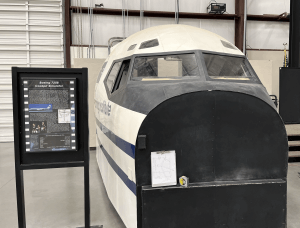
One window on each side of the 720 cockpit could be opened by pulling it in, then sliding it aft down angled rails (one under the sill, and another running diagonally across the window behind). The openings were emergency exits, large enough to crawl through.

The opened window was an irregular diamond shape with rounded corners, roughly 16” wide on top and 19.5” on the bottom. The front edge was just under 17” tall. The back edge was 21 inches.
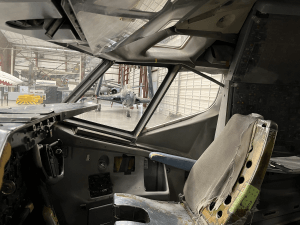
The top edge of the window was only 50.5” off the deck. Mordoch had to crouch, probably with one foot between Yoram’s legs and a shin on Yoram’s lap, to shoot through the open window. I doubt Rahamim took the time to drag the wounded copilot out of the right seat before returning fire.
Measurements I took of the rounded, cone shaped cabin didn’t transfer precisely to the flat 4’x8’ sheet of plywood we used for the side of the flight deck, but the windows we cut out were roughly the same size and shape.
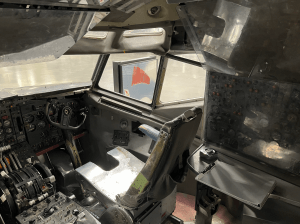
The white-painted portions represented the windscreen and overhead windows that, owing to their angle in front or above, couldn’t be used to see people on the ground beside the plane.
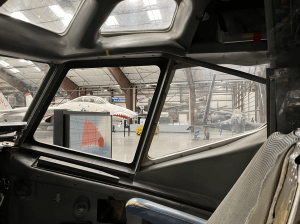
Centerline to wingtip of the Boeing 720 was 22 yards. Assuming the guerillas were some distance past the wing, we posted our fire team targets at about 35 yards. Steel silhouettes would work better for this drill, but we used four cardboard IDPAs.
A dining room chair was our copilot’s seat (don’t tell my wife). A martial arts dummy represented the head and torso of First Officer Yoram Peres. Two rolled-up, duct-taped Army sleeping mats substituted for his legs.
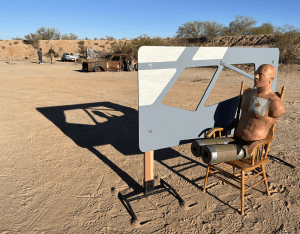
*****
RAHAMIM’S PISTOL
Israeli sky marshals carried Beretta Model 71s. Read Ken Hackathorn’s excellent Combat Classic evaluation of the ’71 in the January 2025 eBluePress to learn more.
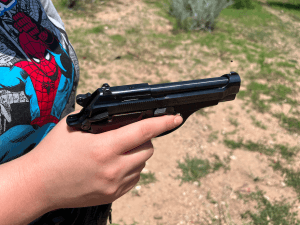
For this drill, any smaller pistol with iron sights will do.
*****
ZURICH DRILL PART 1
The first part of our exercise was not timed, mainly for safety, since it involved some clambering with gun in hand; also because the targets were somewhat distant for a pocket pistol. One cannot miss fast enough to win a gunbattle at any range, but one can hit faster up close than farther away.
The shooter replicating Rahamim’s deeds began seated in “first class,” about 15 feet behind the flight deck. The pistol should start holstered under concealment in what Cooper called “Condition 3” (the US Army calls that “Amber”): eight rounds in the magazine but nothing in the chamber. That’s how the Israelis carried.
On the start command, the shooter stood, faced downrange (as if peering out passenger windows), drew, and chambered the top round. The Israelis racked the slide as part of their drawstroke.

We required the shooter to point the pistol up while moving “in the aircraft,” for two reasons:
- Centerline fuel tanks, hydraulic lines, and wiring of passenger jets are almost always below the deck. Even nearly horizontal NDs angled only slightly downward could go into critical systems in wings or engines.
- Sul or pointing downrange would muzzle the copilot while the shooter got into position by the window.

I don’t know how Israeli sky marshals carried their pistols outside the holster in 1969. Many US police were still using upward pointing readies. The StressFire system of the 1980s had a two handed, bent elbow, upward pointing carry Mas Ayoob called High Ready (we called it “Sabrina,” after Kate Jackson’s character in Charlie’s Angels).

The US Army adopted StressFire as their handgun doctrine, calling their one-handed High Ready “Pistol-Ready” in FM 23-35.

These days we have High Port, which is similar to Pistol-Ready, and Temple Indexed (TI).
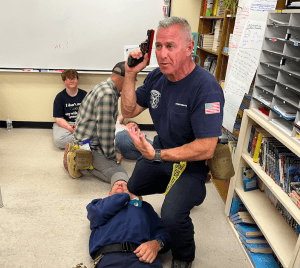
Temple Indexed is safe, but would be problematic in a Boeing 720. Retention (a weakness of TI) was not an issue in Zurich—the attackers were outside—but Rahamim was over 6 feet tall. A pistol in TI might drag along switches and instruments in the low ceiling of the flight deck. I’m 5’4” and I could barely stand up behind the pilots’ seats.

I was not a full-time FAM, but when I flew from 1996 – 2017, I was armed. If I had to close with hijackers inside a cabin, as Rahamim did three years later, on 08 May 1972 (Sabena Airlines flight 571 in Tel Aviv), I might move in High Port when not aimed-in.
If I didn’t know where the hijackers or bombs were, I would clear rows of seats using a compressed, downward-angled Center Axis Relock Combat High hold.
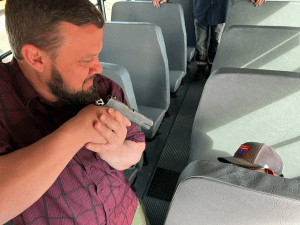
That would regrettably point the muzzle at passengers too. Terrorists with guns and bombs inside an airliner pose a greater threat to the passengers than the potential for a negligent downward discharge by trained rescuers observing Rule 3 (finger along the frame).
But in Zurich, the only gun inside the aircraft was Rahamim’s. The safety of the passengers was paramount, so we pointed our guns up while executing this drill.
Moving to the plywood flight deck, the shooter stepped into position with his or her left leg in front of the seat, right leg kneeling on the rolled up sleeping mat legs of our dummy copilot.

The real Rahamim had to climb over a control panel with throttle levers between the pilots’ seats. We omitted that trapezoidal box in the interests of safety.

The person shooting the drill fired one shot at each fire team target, plus a fifth round at their target of choice. Then they pointed the pistol up again and directed a spectator to render aid to Peres.

*****
THE MED COMPONENT
Most shooting drills end when the shot timer picks up the last shot. My limited experience has been that there is a very messy period of cleaning up after a gun battle. Any time you trade bullets with someone, expect to render first aid, to yourself or others, when the smoke clears. Rahamim may or may not have delegated medical tasks, but our shooters did. It’s a good habit.
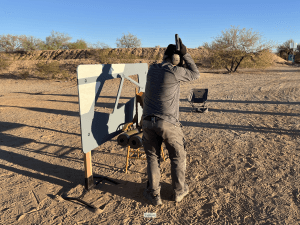
“Driver’s only job is to drive” applies whether you’re ambushed in a car or a jet. The captain and the flight engineer might have had their hands full shutting down engines or closing fuel valves, depending on aircraft damage. But other aircrew or passengers could be recruited to stanch the bleeding.
The rolled-up camping mats we used to simulate Yoram’s legs had holes cut in them for practicing wound packing.
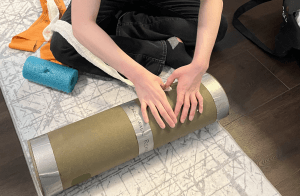
They could also be tourniqueted.
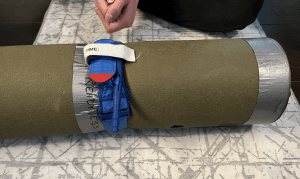
Tourniquets were not as popular in the 1960s as they are now, but they have been emergency medical tools since the 1600s, and probably before. The Zurich Drill is run one shooter at a time, so getting quality reps of essential medical skills gave the other shooters something beneficial to do while waiting for their own trigger time.
*****
ZURICH DRILL PART 2
We timed the second part of the drill, to give the shooters incentive to run fast.
The Boeing 720 had four doors equipped with slides. Rahamim used one of the rear slides to get to the tarmac. I have trained in mothballed aircraft, but we didn’t have one on the range to work with. We didn’t shoot from a raised platform or try to simulate egress.
When the shot timer started, our sky marshal understudy ran to the right side of the range, about the 33 yard length of the 720 passenger cabin. Then the shooter turned left (downrange) and ran till they flanked the target array. The targets were angled about 40 degrees so they could be hit from uprange and also from the right. Our range had a circular berm. As with many action shooting bays, we had the luxury of left and right traverse, so long as we did not break the 180-degree plane.

The targets were numbered 1 – 4. When the shooter reached the second firing point (we marked ours with a traffic cone), the RO running the shot timer called out a number, designating the “leader.” The shooter put three rounds into that target, ending the timed portion of the drill.
After stopping the clock, you could use a bullhorn siren or simply yell “Polizei!” as a signal that your shooter should set their gun down and step away with their hands up, fingers splayed—a survival response every concealed carrier should practice. Lay down a door mat or piece of cardboard to set the gun on.
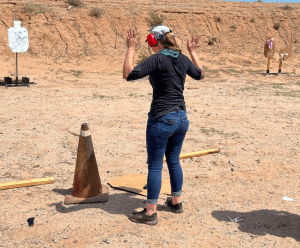
*****
SCORING
Eight hits were possible. Because of the distance, and the crouching on one foot, we decided to score holes anywhere on the target as hits. With such forgiving scoring, and only three closer shots against the clock, we elected a hefty penalty of 20 seconds per miss. You could choose to add 10 seconds (or whatever) per miss instead.

*****
THREE SIDES TO EVERY STORY
I worked much of my adult life in counterterrorism security. I don’t condone the murder of civilians by anybody. While I can’t abide the PFLP-GC’s methods, I must admit that those four Palestinians, one female, were committed to their beliefs. And whatever your stand on the Holy Land, you must admit that what Mordechai Rahamim did that winter day in Zurich was extraordinary.
As with airliners, when people shoot up your school or your shopping mall, their motivations will be irrelevant. Reporters and pundits will dwell on “why” ad nauseam later, but when it’s happening, your only concern will be that the killers are stopped. Barricading your door may save you, but not your neighbors. A bullet in the killer’s head will stop the killing.
Mordechai Rahamim counterattacked a heavily armed fire team.
By himself.
With a .22.
He showed us what one dedicated protector can accomplish against serious odds, with only a handgun, training, and raw, unadulterated courage.
